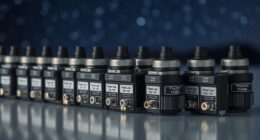Capillary electrophoresis (CE) allows you to quickly separate charged molecules within tiny capillaries, offering high resolution and speed while using minimal sample amounts. This technique works by applying an electric field that moves molecules based on their size-to-charge ratio, making it ideal for analyzing proteins, nucleic acids, and metabolites. Its compact setup enables rapid, efficient analysis suitable for various fields. If you want to explore how this technology can improve your analytical work, there’s more to discover ahead.
Key Takeaways
- Capillary electrophoresis separates charged molecules quickly using narrow capillaries based on size-to-charge ratio.
- Its high resolution and fast analysis make it ideal for identifying proteins, nucleic acids, and small metabolites.
- Miniaturization into microfluidic devices further accelerates separation and reduces sample and reagent consumption.
- Coupling with advanced detection methods like fluorescence enhances sensitivity and rapid data acquisition.
- Innovations in materials and automation continue to improve speed, accuracy, and applicability of capillary electrophoresis.

Capillary electrophoresis is a powerful analytical technique used to separate charged molecules based on their size-to-charge ratio. It’s known for its high resolution, speed, and minimal sample requirements. Recently, one of the most exciting developments in this field is microfluidic integration. By incorporating capillary electrophoresis into microfluidic devices, you can miniaturize the entire process, making it faster, more efficient, and more suitable for point-of-care testing or on-site analysis.
Microfluidic integration miniaturizes capillary electrophoresis for faster, more efficient point-of-care and on-site analyses.
Microfluidic integration allows precise control over small fluid volumes, reducing reagent consumption and increasing throughput. This integration also simplifies the setup, often eliminating bulky equipment, which makes portable devices feasible. For you, this means easier deployment in diverse environments such as clinical labs, environmental monitoring, or food safety testing.
Application advancements have profoundly expanded what capillary electrophoresis can do. Modern innovations enable the technique to analyze complex biological samples, like proteins, nucleic acids, and metabolites, with greater accuracy and speed. For instance, coupling capillary electrophoresis with mass spectrometry now allows you to identify and quantify trace compounds more effectively.
Recent developments have also improved separation efficiency and reduced analysis time, which is vital in clinical diagnostics where rapid results are essential. Additionally, advancements in capillary coating and buffer systems enhance separation performance and reproducibility, making the technique more reliable for routine use. Further improvements in the materials used for capillary coatings continue to enhance the durability and performance of the system.
You’ll find that these application improvements often stem from integrating automation and sophisticated detection methods. Automated sample loading and data analysis streamline workflows, saving you time and reducing human error. Furthermore, the use of laser-induced fluorescence or electrochemical detection boosts sensitivity, letting you detect even minute amounts of analytes.
The ongoing research into novel materials and nanotechnology further pushes the boundaries, enabling faster, more sensitive, and more versatile analyses. These innovations open doors for new applications in personalized medicine, environmental assessment, and quality control.
Frequently Asked Questions
How Does Temperature Affect Capillary Electrophoresis Results?
You might wonder how temperature affects your capillary electrophoresis results. Temperature control is vital because thermal effects influence the separation process.
When the temperature rises, the viscosity of the buffer decreases, speeding up migration times. Conversely, lower temperatures slow down the process.
Maintaining consistent temperature guarantees reproducible results, reduces variability, and improves resolution. So, paying attention to temperature control helps you obtain accurate, reliable electrophoresis data.
What Types of Samples Can Be Analyzed With This Method?
Think of capillary electrophoresis as a Swiss Army knife—you can analyze a wide range of samples. You can examine biological samples like proteins, DNA, and peptides, as well as environmental pollutants such as pesticides and heavy metals.
Its versatility makes it a go-to method for quick, precise separation of these complex mixtures, giving you clear insights whether you’re working in medical diagnostics, environmental testing, or research labs.
How Is Capillary Electrophoresis Different From Traditional Gel Electrophoresis?
You see, capillary electrophoresis differs from traditional gel electrophoresis mainly through its use of microfluidic innovations and automation techniques. Unlike gel electrophoresis, it employs tiny capillaries instead of gels, allowing faster, more precise separations.
You benefit from reduced sample and reagent consumption, higher resolution, and easier automation, making it ideal for rapid analysis. This method streamlines workflows and enhances data quality compared to traditional gel-based methods.
What Are Common Challenges Faced During the Procedure?
While exploring capillary electrophoresis, you might find some hurdles along the way. Sample contamination can subtly influence your results, and capillary clogging can slow down your process.
These challenges require careful handling and maintenance to keep things running smoothly. Staying vigilant and maintaining your equipment helps guarantee accurate separations and reliable data, turning potential obstacles into opportunities for learning and mastery.
How Is Data Accuracy Maintained in Rapid Separations?
To maintain data accuracy during rapid separations, you should minimize sample variability by using consistent sample preparation techniques. Regular calibration accuracy checks guarantee your equipment produces reliable results.
Additionally, controlling variables like temperature and voltage helps prevent fluctuations. Implementing quality control samples and replicates further verifies your data’s precision, ensuring that rapid separation results are both accurate and reproducible.
Conclusion
You can see how capillary electrophoresis offers lightning-fast separation, often in just minutes. Did you know it can analyze tiny sample volumes as small as nanoliters? This technique’s speed and efficiency make it perfect for fields like forensics and medical diagnostics. So, next time you hear about rapid lab tests, remember capillary electrophoresis’s role in making quick, accurate results possible—saving time and improving outcomes in countless applications.









